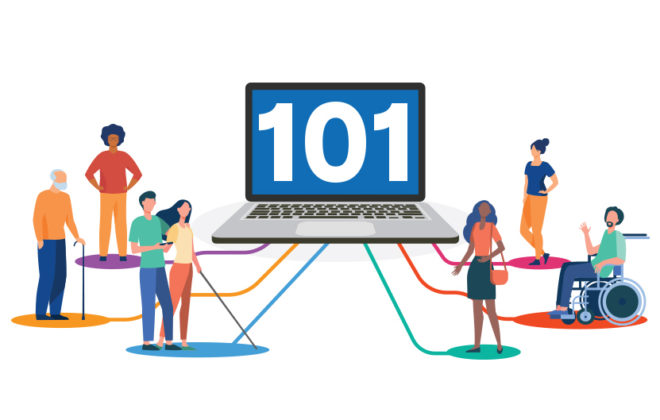Coronavirus lock-down measures may have stopped the global economy in its tracks, but workers around the world were quick to adapt to new technologies, pick up where they left off, and carry on.
Many UX designers and researchers made the switch to remote moderated user testing to keep their website design projects on track. If you’re more experienced with face-to-face research, you’ll need to tweak your approach – and be prepared for some new challenges – in order to get the most out of UX research using online usability testing.
Challenge 1: Managing technical difficulties
Sometimes, the old adage that it’s the user, not the tech, at fault, is not always true. Occasionally, it really is the tech. No amount of switching on and off your PC (or checking you’re plugged in) can solve a poor internet connection.
With the increased web traffic that has resulted from the ‘work from home’ directives, internet connections have been patchy. During usability testing, this can result in a hiccups in the recording or cause difficulty hearing the participants. If you lose your connection completely, try hot spotting from your phone to computer. If that’s not possible – stay calm and try again later.
There are technical obstacles that can be avoided if you take the time to do a little planning in advance. Firstly, make sure everyone involved has installed the right technology. Then, do a test the day before the real session: a sound check with your microphone, a trial with the video camera, and a general exploration of how the testing platform records and plays back.
Use a friend or colleague as a guinea pig and take them through the whole testing process. Forward-prep has the added bonus of making you feel a lot more confident rolling out the testing with strangers.
Challenge 2: Missing the non-verbal, visual cues
In a face-to-face UX test, you pick up on silent cues that speak volumes: the frown that suggests a webpage is confusing, a smile that indicates the right resource has been located, a yawn of boredom over a popup offer that was supposed to be exciting. When you’re remote testing, how do you replicate this added layer of feedback to give your research depth?
Prepare questions in advance
If your moderator is a people person, they’ll naturally engage in a dialogue that draws the participant into a conversation to probe their reactions.
For the rest of us, preparation is key. Brainstorm a list of questions in advance, and then hone in on those that are simple to express, open-ended, and spark meta-thinking – thinking about thinking.
Ask open-ended questions
Avoid closed questions (they’re the ones with a ‘yes/no’ answer). Instead of asking ‘Did you find it easy to navigate to this page?’ use ‘What were you expecting to see on the site to help you find your way here?’. This technique helps your participant verbalize the mental process they went through as their eyes scanned your website.
Avoid leading questions
Don’t ask ‘Do the colors of the site suggest this is a luxury brand’? You’ve put the idea of ‘luxury’ into their mind. Instead, try ‘What does this pink color and cursive font remind you of?” Some people have trouble verbalizing their feelings and thoughts. If this question causes stunned silence, have a multiple-choice question up your sleeve. You can follow with “Do you think this site is selling a luxury product, a product that will appeal to millennials, or something for those who are budget-conscious?”
Choose a UX tool that includes video
Face-to-face contact can never be beaten for the highest quality human interaction. It’s the same for usability testing. Find a UX tool that offers both audio and video recordings if you want to observe your participants in action. You can then round out your questioning with references to facial expressions, pauses, or confident movements. Most Loop11 customers use both our audio and video features to capture the full range of user experience in their testing.
Challenge 3: Recruiting the right participants
Almost half of all UX professionals say that recruiting participants is one of their biggest challenges.
Outsourcing recruitment to a specialist firm can save time and leave you to do what you do best – design and carry out the study! For outsourcing to be effective though, you need to give the firm a clear brief. Outline the context of your study and what you hope to achieve, and list the key demographics of your target audience.
Recruitment is far more than a ‘bums on seats’ exercise. You want to find the right participants, or the feedback you get may be compromised. When Loop11 sources participants to join our ever-growing user pool, we run stringent qualification tests. We make sure people are categorized correctly so they can be directed to the right kinds of projects. We also ensure they are equipped and prepared to undertake the tests. In particular, it’s important to make sure that any participants a third-party recruits for you have signed off on allowing you access to their microphone and/or video. People are conscious of their privacy and you don’t want them pulling out of a test at the last minute if this hasn’t been covered off at the outset.
On your way to successful remote moderated user testing
Remote user testing is a juggling act. You need to keep the conversation going, watch the user’s onscreen behavior, take notes, listen to comments from your team and keep an eye on the time. You also have to exude an aura of calmness and control to set the participant at ease and get the best results.
Practice, preparation, and patience (if tech issues arise) are key to a perfect remote user testing session.
If you’d like to experiment with remote moderated usability testing, jump on our free 14-day trial now.
If you’re new to user testing, get in touch and we can tell you more about how our customers are using remote testing to get awesome feedback on their designs.
![]() Give feedback about this article
Give feedback about this article
Were sorry to hear about that, give us a chance to improve.








